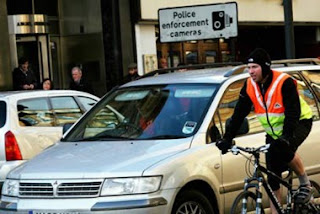Regular cyclists – those who cycle at least once a week – are also disproportionately likely to read broadsheet newspapers, be well educated, have a household income of at least £50,000 per year and shop at Waitrose, claims the latest Mintel report, Bicycles in the UK 2010. In addition, they are twice as likely to be men as women.
"Thirty or 40 years ago, people would ride a bike for economic reasons, but our research suggests that nowadays a bicycle is more a lifestyle addition, a way of demonstrating how affluent you are," said Michael Oliver, who wrote the report for market researchers Mintel.
His research reveals that bike sales are being driven by 35- to 45-year-old family men. Where this age group might once have treated themselves to a sports car – in an attempt to hang on to their youth – they now invest in a luxury bike instead.
The report dubs the upsurge in cycle sales among this demographic as "the noughties version of the mid-life crisis".
Men of a certain age now pride themselves on their bicycle collection. In a documentary last year, Alan Sugar showed off the full-carbon Pinarello machines he has bought for his many residences at a cost of many thousands of pounds each.
Halfords, the UK's biggest bike retailer, confirmed the trend, reporting a rise in interest in all cycles, particularly among top-of-the range products. Premium sales as a whole are up by around 54% in the past two years.
Pashley, a British firm which makes traditional-style bikes, said it had seen sales of some everyday models rise by 50% year-on-year.
However, just 12% of adults questioned by Mintel said they cycled regularly, while 65% said they never rode a bike. One in seven (15%) said they were "lapsed cyclists" who had a bicycle which they no longer rode.
The main reason given for not cycling was safety, with 39% of respondents saying it is too dangerous to ride a bicycle on the road. Women aged 45 or older are the most likely to be put off by the perceived danger of road traffic.
Many people (24%) said they would cycle more often if there were more bicycle lanes, and 14% said while they would like to bike to work, cycling wasn't practical because of a lack of showers or changing facilities.
Ten percent of the sample of 1,557 viewed cyclists as "a nuisance". That increased to 14% among those who regarded cycling as too dangerous. The most antagonism towards cyclists was reported among consumers in the south, south-west and London regions, but there was no real difference among car owners and car-less respondents, said Mintel.
After the success of British cyclists in the Olympic velodrome in Beijing in 2008, there was hope that a new generation of riders would be inspired by the likes of gold medallists Chris Hoy and Victoria Pendleton. But Mintel's research suggested the effect had been negligible among non-cyclists.
"Successful British cyclists, although arguably more high profile than ever thanks to the success of Sir Chris Hoy, for example, have not managed to inspire the general population, with only 2% of respondents admitting this was an incentive to take up cycling," the report claims.
But at the same time, Mintel's survey reveals that British Cycling – the body which administers the sport in the UK – claims to be the fastest growing cycling organisation in the UK, reporting 25% growth between May 2009 and May 2010.
Another cycling organisation, the CTC (Cyclists' Touring Club), which focuses on leisure cycling, has also experienced recent growth of 8% year-on-year, and now has almost 66,000 members. These members are major enthusiasts; they spend on average £700 plus and own an average of 2.2 bicycles, according to recent CTC figures.
Roger Geffen, Campaigns and Policy Director for the CTC, said the government should do more to make the roads safer for cyclists in a bid to encourage more people to get on their bikes, particularly women.
We know that the higher the level of cycling, the more the gender imbalance evens out," he said. "In the Netherlands and Denmark, where far more people cycle, 55% of all bike trips are made by women."
Mintel estimates that the bike trade will boom over the next five years. Last year 3.6m bikes were sold in the UK. By 2015 Mintel expects that figure to rise to just over 4m.
But Mark Walmsley of the Association of Cycle Traders said there had not yet been a real cycling boom nationwide. "There have been some pockets of the country which have seen an increase in people buying bikes, for example in London, but nationally, there has been no boom. All of this hype that's going on is rubbish."
